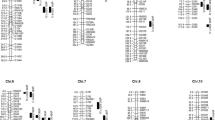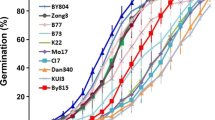Summary
This research was designed to map the genes in maize which condition a high response to anther culture using RFLP analysis. A set of 98 S1 families were developed from the cross of B73 × 139/39-05. In vitro-cultured anthers of 139/39-05 produce numerous embryolike structures while anthers cultured from B73 produce none. Plants from each of the families were grown in the greenhouse. Tassels were harvested from ten individual plants within each family and pretreated prior to culture. Up to three Petri dishes with 60 anthers each were cultured from each tassel. Response was measured as the number of embryo-like structures per 100 anthers cultured. In excess of 105 RFLP clones were screened to detect polymorphism among the parents. A subset of 75 widely distributed clones were scored in the 98 families. Based on the analysis of the resulting genetic data set, the high anther culture response observed in 139/39-05 is conditioned by two major recessive genes, which are epistatic, and two minor genes. One of the two major loci resides in the proximal region of the long arm of chromosome 3 near the indeterminate gametophyte (ig1) gene. The second major locus maps to the centromeric region of chromosome 9. The minor genes reside on chromosomes 1 and 10. Fifty seven percent of the variability among the 98 family means is explained by a genetic model which includes these four chromosomal regions. Moreover, segregation at these loci explains much of the variability observed within the families.
Similar content being viewed by others
References
Anonymous (1991) The GLM procedure. SAS/STAT User's Guide, version 6, 4th edn. vol 2. The SAS Institute, Cary, N.C., USA.
Armstrong CL, Romero-Severson J, Hodges TK (1992) Improved tissue culture response of an elite maize inbred through backcross breeding, and identification of chromosomal regions important for regeneration by RFLP analysis. Theor Appl Genet (in press).
Barloy D, Denis L, Beckert M (1989) Comparison of the aptitude for anther culture in some androgenetic doubled haploid maize lines. Maydica 34:303–308.
Chu CC (1978) The N6 medium and its application to anther culture of cereal crops. In: Proc Symp Plant Tissue Culture. Science Press, Peking, pp 43–50.
Cowen NM (1988) The use of replicated progenies in markerbased map** of QTL's. Theor Appl Genet 75:857–862.
Dieu P, Beckert M (1986) Further studies of androgenetic embryo production and plant regeneration from in vitro cultured anthers of maize (Zea mays L.). Maydica 31:245–260.
Helentjaris T, King G, Slocum M, Siedenstrang C, Wegman S (1985) Restriction fragment polymorphisms as probes for plant diversity and their development as tools for applied breeding. Plant Mol Biol 5:109–118.
Kermickle JL (1969) Androgenesis conditioned by a mutation in maize. Science 166:1422–1424.
Ku MK, Cheng WC, Kuo LC, Kuan YL, An HP, Huang CH (1978) Induction factors and morpho-cytological characteristics of pollen-derived plants in maize (Zea mays L.). In: Proc Symp Plant Tissue Culture. Science Press, Peking, pp. 35–42.
Mitchell JC, Petolino JF (1991) Plant regeneration from haploid suspension and protoplast cultures from isolated microspores of maize. J Plant Physiol 137:530–536.
Morosz S, Donn G, Nemeth J, Dudits D (1990) An improved system to obtain fertile regenerates via maize protoplasts isolated from a highly embryogenic suspension culture. Theor Appl Genet 80:721–726.
Petolino JF (1990) Use of anther culture and related procedures for corn improvement. 44th Corn and Sorghum Res Conf. American Seed Trade Assoc., Washington, D.C., pp 63–75.
Petolino JF, Jones AM (1986) Anther culture of elite genotypes of maize. Crop Sci 26:1072–1074.
Petolino JF, Thompson SA (1987) Genetic analysis of anther culture response in maize. Theor Appl Genet 74:284–286.
Petolino JF, Jones AM, Thompson SA (1988) Selection for increased anther culture response in maize. Theor Appl Genet 76:157–159.
Raghavan V (1990) From microspore to embryoid: faces of the angiosperm pollen grain In: Nijkamp HJJ, VanderPlas LHW, VanAartrijk J (eds) Progress in plant cellular and molecular biology. Kluwer Academic Publishers, Dordrecht, pp213–221.
Saghai-Maroof MA, Soliman KM, Jorgenson R, Allard RA (1984) Ribosomal DNA spacer length polymorphisms in barley: Mendelian inheritance, chromosomal location and population dynamics. Proc Natl Acad Sci USA 81:8014–8018.
Southern E (1975) Detection of specific sequences among DNA fragments separated by gel electrophoresis. J Mol Biol 98:503.
Southern E (1980) Gel electrophoresis of restriction fragments. Methods Enzymol 69:152.
Author information
Authors and Affiliations
Additional information
Communicated by G. Wenzel
Rights and permissions
About this article
Cite this article
Cowen, N.M., Johnson, C.D., Armstrong, K. et al. Map** genes conditioning in vitro androgenesis in maize using RFLP analysis. Theoret. Appl. Genetics 84, 720–724 (1992). https://doi.org/10.1007/BF00224175
Received:
Accepted:
Issue Date:
DOI: https://doi.org/10.1007/BF00224175




